MLB Returns: As RSNs Handle World Feeds, Sinclair’s Fox Sports RSNs Shoulder Production Load
At the start, the focus is on the fundamentals
Story Highlights
In an effort to reduce production crew and facilities onsite for safety this MLB season, regional sports networks have been tasked with producing a neutral world feed for all MLB teams home games to be distributed to the away-team RSNs and national broadcasters. SVG is delving into how each RSN group is handling this new production model as part of its MLB Returns series to open the 2020 season.
No broadcaster will play a greater role in creating the live baseball that fans see this season than Sinclair’s Fox Sports Regional Networks. As the regional broadcaster for roughly half of Major League Baseball’s 30 franchises, Sinclair’s RSNs will be responsible for creating the world feed delivered to away-team RSNs and national broadcasters around the country. It’s a lot of pressure — especially in the era of COVID-19, which has transformed the way live sports productions are carried out. The Fox RSNs are starting out this season by focusing on the fundamentals.
“Our philosophy is to keep it pretty simple to start and then build from there,” says Mike Connelly, EVP, Sinclair/Fox Sports Regional Sports Networks. “We believe that we have to get good at this first before we start adding a bunch of technical [elements] or special content. We’re working really hard with the other networks to make sure that we get a good, unbiased production because, ideally, we want to be able to rely on that world feed for the most part. Of course, we’ll look at new technology and elements as the season goes on, but, right now, we just want to make sure that we get the basics.”
Behind the Scenes: Mobile TV Group Dual-Feed Trucks Provide Social Distancing
To limit the number of people and facilities onsite, the league has opted to have the home-team RSN in each market produce the neutral/clean world feed of each game. This “50-50” unbiased feed is delivered to the away RSN, which adds its own graphics, commentary, studio/shoulder content, and commercials. In addition to this clean feed, the away RSN is provided with one dedicated iso camera allowing the away director to weave in team-specific shots to help customize the telecast.
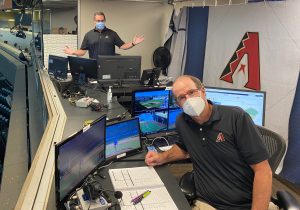
Fox Sports Arizona talent in booth at Chase Field calls a Diamondbacks Summer Camp at Dodger Stadium.
For the most part, Fox RSNs are deploying their usual Mobile TV Group dual-feed two-truck mobile units at the ballpark to produce these world feeds. Although the away RSN’s production team is not onsite, the VMU (visitor mobile unit) is in the compound in most cases to enable the home RSN to socially distance its crews.
“We’ve been working closely with MTVG on how to distance everyone,” says Steve Grigely, VP, technical operations, Sinclair/Fox Sports Regional Sports Networks. “We’ll have a divider in production because we want to keep the producer and director in the normal spots, but we can move graphics, scorebug, and other [operators] into VMU where it’s available. Even when a VMU is not available, we still think we have a very solid plan to keep people separate and limit it to one or two people at each bench.”
Behind the Mic: Announcers Learning To Call Games Off-Monitor
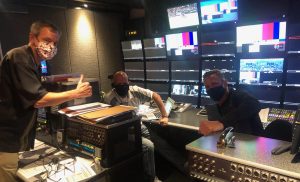
Inside the Fox Sports Arizona truck with (from left) Diamondbacks producer Jeff Gowen, director Brian Maas, and TD Joel Blosser.
Announcers will be at the ballpark split between separate booths to call home games. Some will also be in the booth onsite to call away games off-monitor remotely; others will shift to the RSN’s studio to call these games. When calling games off-tube from home, away announcers are provided four feeds on large monitors: the program feed, an “all-9” angle of the entire field, dedicated iso camera feed, and a quad multiviewer feed (provided by MLB Network) showing various ballpark POV cams of the bullpens, scoreboard, dugouts, and so on. They also have a routable feed with which producers can feed talent replays or other packaged content.
“I think the biggest challenge is making sure talent are comfortable, because they’re used to seeing things a certain way from a booth onsite above home plate,” says Grigely. “And now we’ve got to make sure that they can see all nine players on the field at all times, as well as be connected to the production truck or the control room. Providing them with a setup to make them comfortable — especially based on the limitations we have — has been a challenge, but we’ve gotten good feedback so far.”
On the Field: More Robos Down Low and Mics on Players
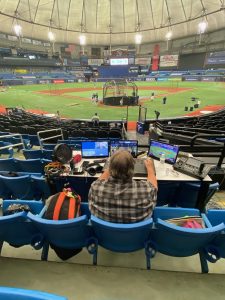
A Fox Sports Florida robo operator is located in the stands at Tropicana Field for a Tampa Bay Rays Summer Camp game.
Although camera complements have remained largely the same overall, the bulk of the low positions have been moved farther from the field, quarantined to separate them from the players, or converted to unmanned robos. The empty stands will provide broadcasters with more leeway to experiment with new camera positions, Grigley says but notes that Fox RSNs will stick to traditional positions to begin the season.
“We don’t want to be putting cameras in random spots until we know these [broadcasts] are being well-executed and the team is okay with how everything works,” he explains. “The league has been really good about working with us on [camera positions], but it’s just a much stricter credential now to be closer to the players now. We want to start with a solid show with our normal cam positions, and we’ll have our robos down low, and then we can learn and expand off from there.”
Fox is also looking to mike up players on the field when possible and potentially outfit them with IFBs for in-game interviews with announcers.
“Once baseball and the players union sign off on it,” says Grigley, “we’ll be first in line to mike up the players. We need to make sure that the audio person who’s going to [outfit the mic on the player] gets that higher-tier credential to be around the players, and we’ll take all the [necessary] precautions. We have one team that’s being more aggressive than the others right now, so we’ll probably use them as a launch point in the near future and then see where it goes from there.”
In the Stands: Virtual Signage, Simulated Crowd Noise, and Zoom Calls With Fans
With no fans in the stands, virtual signage will have a much larger role in MLB broadcasts this year. All but three of the teams carried by Fox RSNs (Cleveland, Anaheim, and Tampa Bay) will be integrating virtual signage into their in-market telecasts (virtual signage will not be available to away RSNs). The Fox RSNs have enlisted Brand Brigade to handle virtual signage, which is primarily inserted downstream at the broadcasters Network Operations Center in The Woodlands, TX.
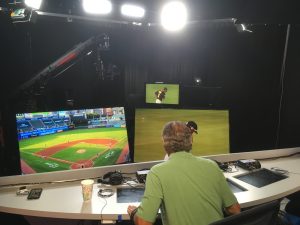
Cincinnati Reds play-by-play announcer Thom Brennaman checks out monitors in the studio during a Fox Sports Ohio tech rehearsal on Monday.
Like most RSNs, Sinclair’s networks will be integrating the simulated crowd noise pumped into each ballpark as part of its nat sound, rather than incorporating it directly into the broadcast audio mix. Although there will be no fans in the stands, several of Sinclair’s RSNs are looking to integrate fans into the telecast via videoconferencing and social media.
“Some of our RSNs are working on creating a situation where they can bring Zoom into the broadcast with fan reactions,” says Connelly. “Once again, we’re going to hold back for a little bit until we get good at this new way of producing games. Once we get our feet under us, we’ll start bringing in those elements. There’s always risk when you bring in fans that aren’t used to broadcast. There’s that unpredictable element to it, so we have to make sure we pick the right fans and are smart about it.”
Safety Measures: Keeping the Crew Healthy
Every Fox RSN production truck and studio-control room has stringent safety protocols mandating that crew members maintain social distance, wear PPE at all times, and arrive precisely at their call-time to minimize the number of people onsite (any staffer able to work from home has continued to work remotely). The operations team has also separated the crew into functional groups, isolating individuals to a single working area (the A unit, the VMU, inside the ballpark). In addition, all crew members have been required to sign a pledge to follow all these safety standards if they wish to continue working live productions.
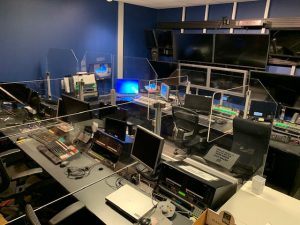
Fox Sports Detroit’s control room has been outfitted with extensive plexiglass dividers to protect the crew.
“First thing we wanted to do was make sure that everybody commits to certain courses of action and social-responsibility pledges: committing to wearing a mask, following the basic CDC guidelines, and so on. By signing that pledge, we feel that we have a buy-in from everybody above the line and below the line, as well as our union partners. We’ll be providing the basic PPE product onsite for all of our RSNs.
The team has also contracted with several third-party infectious-disease experts to develop a corporate playbook for safety, as well as provide temperature screenings and medical services at production sites. The goal is to keep crews healthy and productions rolling without incident.
“The biggest thing has just getting been everybody back to work on the productions,” says Connelly. “This was a big task, to say the least, and Steve, [VP, Production,] Ron Gralnik, [VP, Production,] Nick Davis, and the rest of the team have been amazing. It’s really exciting to have these events coming back on the air after all the darkness over us the last four months. And we hope it brings some positivity back into the country. This has certainly been the biggest challenge of my career, and the entire team has worked extremely hard. So we’re excited to be able to get sports back on the air.”
Check out all of SVG’s ‘MLB Returns’ coverage:
- RSNs Take Over World Feed for All MLB Broadcasts, Customize for In-Market Fans
- ESPN Preps Normal Sunday Night Baseball Graphics Package for ‘Enhanced World Feed’
- Wearing Two Production Hats, MLB Network Deploys Full At-Home Model, Provides RSN Infrastructure
- Baseball Has Its Crowds on an iPad With Artificial Fan Noise
- As RSNs Handle World Feeds, Sinclair’s Fox Sports RSNs Shoulder Production Load
- NBC Sports Regional Networks Seeks Balance Between World Feed and Serving In-Market Fans
- NESN To Produce ‘Red Sox-ized’ In-Market Broadcasts in Addition to World Feed
- AT&T SportsNet RSNs Use Mix of Studio, Mobile Facilities for World Feed, In-Market Productions
- MASN Tested Early With Back-to-Back-to-Back World Feeds for National Broadcasts
- Fox Sports Augments MLB on Fox Telecasts With Virtual Fans
- …and stay tuned for more next week!
